Table of Contents
Conversion Chart
We love formulas, don’t we. We convert currencies, units of measurement, and we software to convert complex digital files from one format to another. Nowadays we can even rely on software to translate languages back and forth instantly for us, and while it doesn’t always work great, it’s at least helpful.
So when it comes to eyesight, surely we can convert everything too!
I’m guessing you’re in one of two situations, if you’re looking to convert diopters and acuity.
Either:
- You have a glasses prescription and you want to know whether you have 20/40 or 20/200 vision, or
- You have an eye chart and you want to know what you prescription should be, based on what line you can read.
Ok, I’ll start out by appeasing you, and then I’ll tell you why it doesn’t work.
Some people have created believable-looking charts that match up diopters and acuity, such as this one for myopia:
| Prescription in Diopters | Acuity |
| -1.00 | 20/40 |
| -2.00 | 20/80 |
| -3.00 | 20/150 |
| -4.00 | 20/300 |
| -5.00 | 20/400 |
| -6.00 | 20/500 |
Well, all right, that sure looks helpful. And it’s not totally useless. For some people it will be about right.
For others, it will be way off.
For hyperopia, people often just try a few pairs of glasses on at the drug store and buy the pair that helps them read the book in their hands.
Converting these things are a bit like taking an average of how much weight a bodybuilder can lift based on his muscle size. There’s a relationship, but geez, there’s also some small guys with really dense, small muscles and an uncanny ability to pull a ridiculous amount of weight off the floor due to their training and muscle efficiency.
So it is with vision. Not so much to do with muscles, but the brain. Some other optical factors are at play too.
Here’s the problem. Diopters are an objective measurement. Here’s how it’s calculated…
Diopters and Blur
For glasses prescriptions, the diopters on your prescription such as -5.00 tells you how far your eyes can focus and therefore how much lens power is needed. It’s basically an inverse of the distance to your “edge of blur”. If you’re nearsighted and look at a sample of fine print and find that it begins to blur at 20cm away, your prescription would be -5.00.
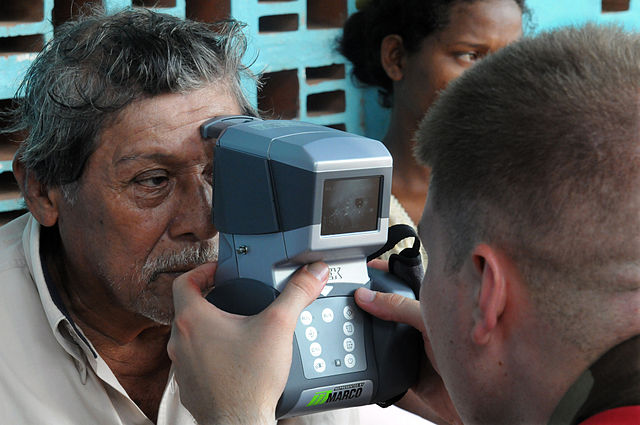
When your eye doctor determines your prescription, he uses a test that measures the refraction of each of your eyes, which is how much the light is bent as it passes through your eye’s components and then onto your retina. This is done with a device called an autorefractor or retinoscope. It’s where you’re supposed to hold still and stare at something in the corner of the room. When the light is bent too much or not enough, and the light rays would come to a focus in front of or behind your retina, you would be myopic (nearsighted) or hyperopic (farsighted) and given the appropriate prescription.
The Subjective Test
Your eye doctor also does a subjective test, the old “which is better, #1 or #2?”. He sticks that huge thing on your face that you rest your chin on and look through the lenses. It’s called a phoropter. He flips different lens combinations in place in front of your eyes to see how you respond. I remember those. Half the time they looked the same, or they looked different but I couldn’t decide which was “better”, 1 or 2, so just picked one each time anyway after he flipped it back and forth several times and got impatient, or I insisted they were the same. Is that scientific? It always felt like a crapshoot to me.
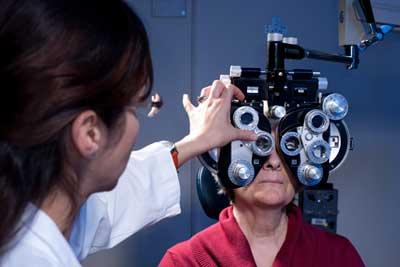
What he’s doing, of course, is giving you two different prescriptions to look through to decide which one is better for you. It all depends on your responses. He flips through a whole series of them, with and without astigmatism correction, until he narrows down on a prescription that you seem to like best, and voila, that’s what you get.
The Visual Acuity Test
He might also have you just read the chart without anything on your face. This will be your 20/xx reading, such as 20/50, 20/80, 20/100, etc. Or if you can read 20/20, you don’t belong there at all.
The “20” part on the top of the fraction represents 20 feet. He may use mirrors to simulate the distance in a small room, but optically he’s always testing you at 20 feet. This is because focusing at 20 feet is pretty much the same as focusing at any farther distance, and 20 feet therefore can be considered “distance”.
In countries using the metric system, the first number will be “6”, for 6 meters. Same distance, roughly.
The bottom number, ie: the “40” for example in 20/40, may seem kind of convoluted but makes sense when you wrap your head around it. It represents the label on the smallest line you can read, which is labeled such because a person with “good” vision can read that line from that distance away. So if you can read the 40 line, your vision is 20/40, and a person with good vision should be able to read that line from 40 feet away, while you have to get up to 20 feet to barely read it.
As you may be learning at this point, this is all pretty rough, despite those convincing looking decimal points in a prescription like -4.25. That’s why they have to test your vision in so many ways, to kind of triangulate on a prescription because otherwise you often get a prescription that doesn’t work for you. Even then, sometimes it makes you dizzy and you have to go back two or three times to get a different prescription. Why do you suppose that is?
Converting the Numbers
The table I gave further above is one possible way to understand diopters and the 20/something acuity test.
But there’s a better way to understand it. The real answer isn’t convenient, but it’s much more hopeful as far as your potential for improvement.
Vision Changes
It’s extremely common for people to go from one eye doctor to another and be handed a different prescription.
Why?
When your vision is bad, everything makes a difference. Anything may make you more nervous or cause you to use your eyes more poorly, causing tension and defocus. The time of day, what you were doing today, your state of mind, not to mention things out of your control like the ambiance in the office, the eye doctor’s personality, the order in which he does the tests, the previous prescription he’s going off of… All these factors can change the result.
Granted, if you’ve been wearing glasses for many years, your eyes tend to get locked down with tension, and the tension doesn’t release often, certainly not when your vision is being tested, so the tests from one visit to another will probably lead to the same prescription or pretty close to it.
People who don’t regularly wear glasses, or have never worn them but are starting to experience blurry vision, such as children, or older people who are struggling for the first time to read up close, can get a whole range of inconsistent prescriptions.
The fact is, vision changes.
It changes over short periods of time. Minutes. Seconds. Conventional eye care doesn’t take this into account. It disrupts their models of how the eye works. And if it changes so easily, that means glasses are unnecessary and there must be a way for vision to get better without them more consistently. These cases are a nuisance to eye doctors who would rather believe that there is nothing to be done but give patients glasses (or perform surgery).
One thing I recommend to people working on improving their vision is to get an eye chart and hang it on the wall. They soon find that their vision sometimes improves out of nowhere, lasting a second, several seconds, or even a minute or longer. And then it keeps happening.
Understanding why this is happening is at the core of the approach I promise to reversing vision problems. When you know what is good and bad for your vision, and notice some subtle things that you had thought made no difference to your vision, you gain a new respect for how sensitive your eyes are to your thoughts, emotions and actions.
Is the Prescription Right For You?
If your vision can change so much, how much sense does a single prescription make that you are supposed to wear all the time? Not much. Your eyes have to basically create that amount of myopia or hyperopia in order to see clearly through the glasses. So you can see why glasses might keep your blurry vision locked into place. They confuse your brain. They teach you that your vision is operating exactly the way it’s supposed to and you just need “correction”.
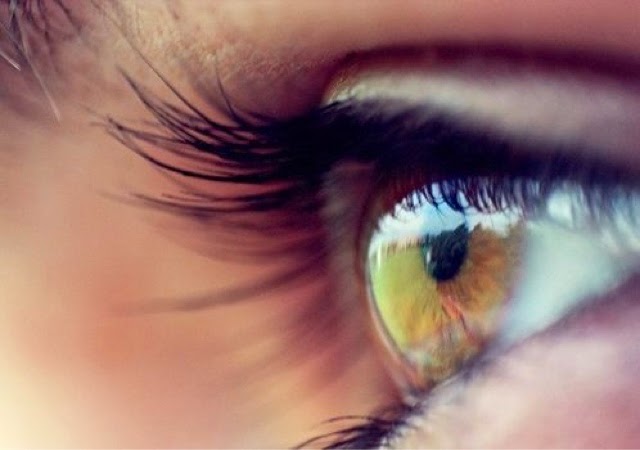
When your vision gets tested, the stress or discomfort you experience at the doctor’s office will usually cause you to experience the worst vision you ever do. So not only are you getting a single prescription that only is good for that moment, but you’re also getting a prescription that is too strong for you at other times! Your system adapts to the glasses by de-focusing your eyes to create that level of maximum blur at all times. Not good, right?
To exacerbate the problem, it’s common for eye doctors to over-prescribe slightly. Say with -3.00 you can read 20/20 on the chart, but he might try bumping it up to -3.25 or -3.50 and see if you can read 20/15 or 20/10. They feel like they’re doing the right thing by giving you stronger glasses. It also stops you from coming back later to complain that the distance is just slightly blurry at night, for example. At night, or in other adverse conditions, you might be straining your eyes more in an attempt to see things, resulting in more defocus that would require a stronger prescription, while during the day perhaps the -3.00 would have been perfect. Once you adapt to these stronger -3.25 glasses, he’ll be ready to give you a pair of -3.50 glasses, and so on.
It’s unfortunate, but keep in mind he’s just providing a service that you’re asking for, in the best way he knows how. The best thing to do is to improve your vision and get out of this vicious cycle of stronger and stronger glasses.
I founded iblindness.org in 2002 as I began reading books on the Bates Method and became interested in vision improvement. I believe that everyone who is motivated can identify the roots of their vision problems and apply behavioral changes to solve them.
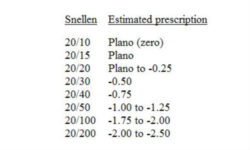
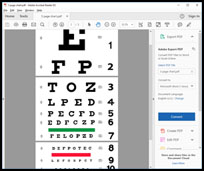
My OD SPH is +0.25, CYL is -2.00, AXIS is 105 and ADD is 2.50. My OS SPH is +0.25, CYL is -2.75, AXIS is 90 and ADD is 2.50. What is my vision on the 20/20 scale?
My prescription was -8.50 in one eye and -9.00 in the other. Am I considered legally blind?
I’m also only 14 btw if that changes anything
You are only considered legally blind if your vision cannot be improved to be better than 20/200 with corrective lenses (glasses or contacts). So, if you are -8.50 and -9.00, but you wear glasses and can see with them at least 20/200, then no, you are not legally blind. (Well, unless you have other visual impairments such as glaucoma, or macular degeneration.) But based solely on your prescription, no.
My glasses are -.50 in each eye, and I wear them all day long, and have 20/25 vision with them.
Without them my vision is a blurred 20/70.
my od is sph -9.75 cyl -0.25 axis 023 and os is sph -10.75 cyl -1.00 axis 176
am I legally blind in my os?
No, you are only ‘legally blind’ if your corrected vision is 20/200 or worse (i.e. while wearing corrective lenses).
Hi David
I’m 67. I got my glasses in grade four, when I suddenly couldn’t see the blackboard for5m the back of the room. I *think* I started around -4 in each eye, and progressed to around -6 by my mid 20s, and has stayed there since.. At the other end, I need to remove my glasses to thread a needle. it started at around do some work occaisionally
Hi David
I’m 67. I got my glasses in grade four, when I suddenly couldn’t see the blackboard from the back of the room. I *think* I started around -4 in each eye, and progressed to around -6 by my mid 20s, and have stayed there since.. At the other end, I need to remove my glasses to thread a needle.
Over the years I have dabbled with Bates to no avail. I did notice, about 10 years ago, that blurring seems to be a matter of choice. While staring at the moon, I could, with concentration, resolve 4 or 5 *sharp* images that clustered and shifted around, so I decided that I might be able to reduce the number of images, and bring them closer together. I discussed this with an ophthalmologist whom I knew socially, and I think he thought me balmy..
Flash forward.. in my semi-retired state, I do some work occasionally, finding myself in shopping plaza parking lots, waiting to be picked up. So I started trying to read signs – road signs, shopping signs, license plates, whatever, mixed with internet on my cell phone. Back and forth, far and near, just like Bates’ beads. The improvement has been shocking. What I now realize, which explains the multiple images and astigmatism, is that, my eye isn’t too long to get focused images, the muscles just need better coordination, and finer movement.
Last week I went to a movie and watched most of it without my glasses. I found your *conversion chart* and realize that I’m somewhere between -1 and -2.
[Shakes head] Fifty-eight stinkin’ years. Why now? Who knows.
LoL.
Hope you are keeping well. Thank you for this informative site.
I had lifelong very poor uncorrected vision (at my draft medical exam in 1968 the Army doctor unforgettably said: “Son, you’re blind”.) My prescription at age 70 was -13.5. Then, a miracle of sorts: cataracts. After surgery my newly-inserted lenses gave me 20/20 vision in both eyes, needing only +2.25 reading glasses. My first words to the eye doc in my post-surgical exam were “If I’d had this vision 50 years ago I would have gone to Vietnam.”
Is there a way to compare vision when your eyes are as bad as mine? I see between 20/40 and 20/50 with my contacts. My contacts are a -15.00 and -14.50, But what would the numbers be for me if a -1.00=20/40 approximately?
Yes, anything is possible. Just learn some of the techniques like palming and sunning, really learn to relax drop your shoulders, and make it a habit, do some every day. There are plenty of books, this website, and programs out there. You may have to try one or more things, but stay with it, keep working your way up the hill so to speak.
I have +8.00 contact prescription. Can’t find a 20/20 conversion chart to get an estimated visual acuity.
The main point of this post is that there is no such conversion because you’re comparing two things that are only loosely related.
I have a prescription of OD -9.25 OS -6.25 , Ax 155 &55, having a difficult time finding a place to fill my script. Is this really that bad of eyesight, I mean i know I see nothing without glasses but the reaction some of the costomer service people had scares me.
That’s considered pretty high, but I have heard of others in that range.
I have -9 I recommend zeni optical. Zeni.com
I believe you mean zenni
Yes, that is “really that bad of eyesight.”
Of all the people you see in public who are wearing glasses, fewer than 4% have such poor vision.
So if my os is 20/40 my od is 20/50 and my ou is 20/20 but they say I need classes what would my prescription be? And the axis what is that? And the sphere and cylinder? And there is a pd? I’m trying to find sunglasses for baseball that are prescription.
You can’t determine your prescription from your acuity (chart reading). I’m also not going to promote getting your first pair of glasses if you’re not wearing them already.
Oh ok thank you and no I am already wearing glasses but thank you
if my contact lens Prescription is power -5.00 BC 8.7 Dia 14.0 what would my eyeglass Prescription be.
Contact lens prescriptions are slightly weaker. From what I’ve seen it’s about 0.25 weaker but I don’t know how they determine it.
I am afraid I will not be able to renew my license in New York. Is there anything I can do to improve my skills?
Thank you, David. Very helpful article. Ann Marie, I faced your exact situation. So some months before I was due to take the test, I started trying to focus across the room at the LED time clock numbers display on the cable TV box, one eye at a time, without glasses on. I tried to make the numbers not look blurry, tilting my head or this way and that and squinting my eyes various ways. I did that a few times most days that I sat in my TV-watching chair. Gradually the numbers became less blurry. I also sometimes took grocery-store-grade eye supplements that contain things like bilberry or lutein. After a few months I found out that I could take my drivers’ eye test at a drugstore pharmacy nearby where I felt comfortable. I did that, and passed the test easily
Can we buy powerful glasses above +12 ( which we have ) through the mail without a prescription?
With most mail order places — Zenni Optical, 39dollarglasses — you are ordering the lenses yourself. They don’t ask to see an official prescription. And, most of these places must go above +12. My husband is. -23 in one eye (about -21 in the other), and our research found that most of them could have helped him if he’d been better than about -15. I know that Zenni goes up to -18. Would it stand to reason that they’d also go up to +18?
I can’t see this webpage.
My BCVA IS RIGHT 20/400 and Left 20/200. I do have Kerataconus, what does all this say about my yvisual acuity.
In the section ‘Diopters and Blur’, shouldn’t the blur at 10 cm for a prescription of -5,00 be a blur at 20 cm?!
Yes, thanks for the correction. Fixed!
To add to your comment, My experience taught me that most optimetrists tends to prescribe for you the maximum correction in order to impress you, especially when you are around small diopeters prescrptions. I remember my first prescription was some thing of the range -0.75 to -1.25, not more, but it was strong enough to make the whole down city buildings on the mountainy Amman-Jordan swing, bend and twist with each and every swing, bend and twist movement of my head. These symptoms disappeared gradually. I got used to it, or in your words, my brain/eyes adopted to the prescription and decided to go to a worse glassless vision in order to obtain a non-blurred glass-aided vision. The rest of the story is known to all who weared glasses at a young age like me where we experienced a growing cycle of more diopetr less accute glassless vision and total dependence on glasses . Glasses parallize the eyes and the brain is dissipted to believe that yes, this is the maximum of I can see without glasses, even wondering would I need my glasses to have crystal clear dreams!.
That’s a good point! I’ll add this to the post. Optometrists sometimes do over-prescribe. I heard one describe it, and he basically felt like he was doing this clients a favor by giving them vision as sharp as possible, and that there was nothing wrong with jacking it up a little. But I think there’s an element of how like alcoholics want other people to drink with them. Give everyone strong glasses to join the club.
I have crystal clear, vibrant, colour-saturated, musical dreams, highly 3D. But my vision has been myopic with ambyopia/diplopia since I was 7. My brain saw differently from outside world when my eyes were bandaged after my surgery at 7. This month, the ophthalmologist said my now surgery would take me from a –14 to a-3. I came on Google to find out negative numerals what? Found out is measurement called diopters. But can’t find a website translates –14. The charts stop at –6. So what, the situation becomes exponential. Many situations go exponential and beyond. Try a couple asymtotes. Forgive my spelling. Maths, yes; spelling, no.
I wrote a reply to myself about how I mis-spelled asymptotes, but, although I tapped hard on POST, it wouldn’t do it.
I am a -7.75 and -7.5, so I think that is 20/875 and 20/850 respectively. You might be a 20/1400? Just a guess though.